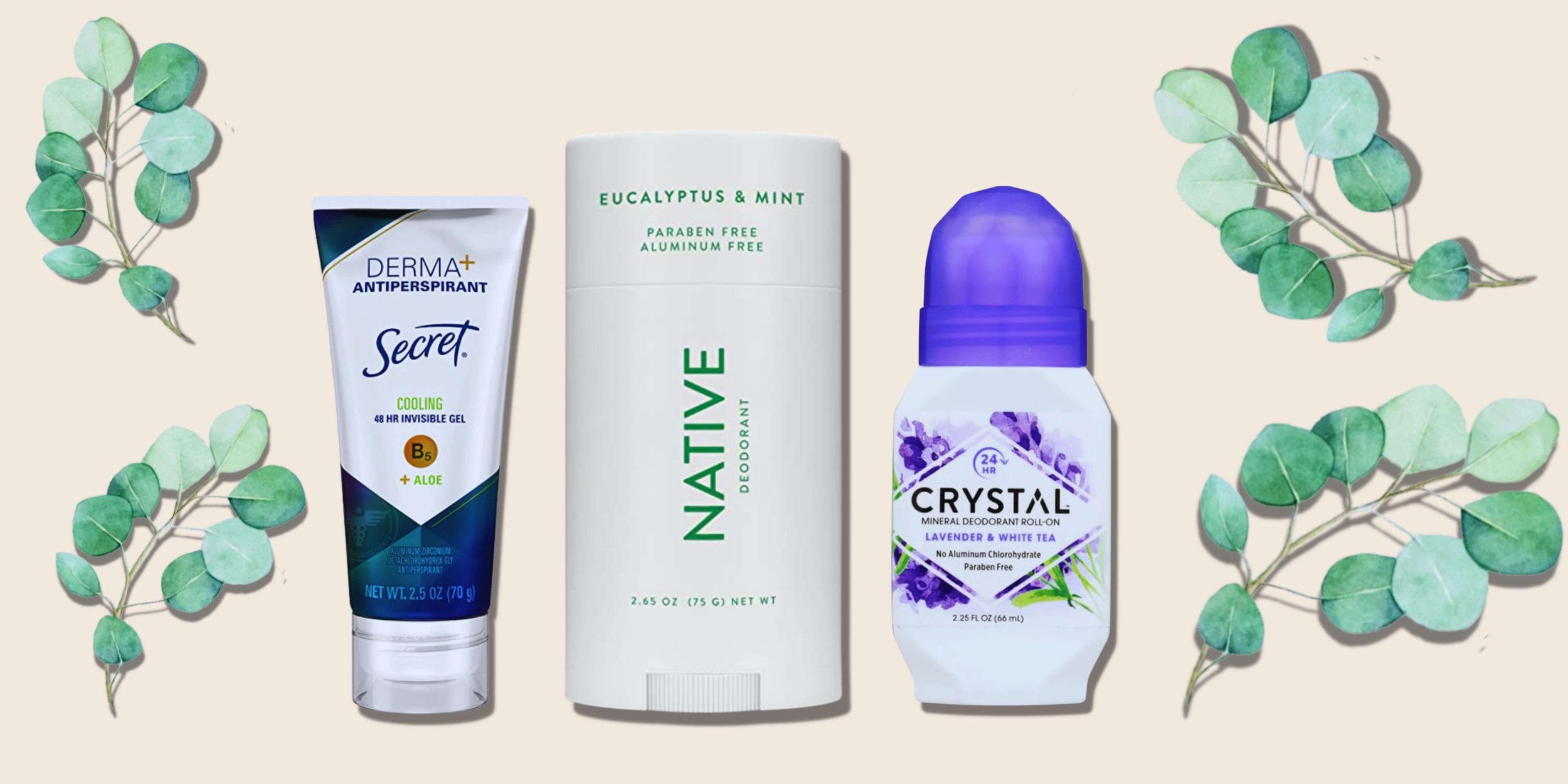Want The Best Deodorant For Your Body’s Needs? Experts Say To Do This
This page may contain affiliate links. As an Amazon affiliate, we may earn a small commission for any purchases made through these links. Click here for the disclosure statement.
The right deodorant is a key ingredient to confidence. Yet, with the overwhelming amount of deodorants available, it can be both hard and expensive to finally find the right sweat and odor-preventing deodorant for your body.
What Should You Look For In a Deodorant?
There’s no easy answer to what is the best type of deodorant. It all depends on your natural perspiration levels and preference for ingredients. Take aluminum, for example. Although aluminum-based deodorants prevent odor extremely well, aluminum itself has been a controversial topic. “It’s better to be safe than sorry,” is what Dr. Rosmy Barrios, MD, believes. In support of that philosophy, Dr. Barrios went on to additionally caution against the use of deodorants that contain alcohol, which can dry and irritate the skin, and “toxic substances like triclosan, propylene glycol, and parabens.”
Natural Mothering Expert, Nancy Arulraj, also explains, some “aluminum-based deodorants have been linked to breast cancer and Alzheimer's.” However, much of the evidence against aluminum as an ingredient remains inconsistent.
Another controversial, yet common ingredient in the world of deodorants is fragrances. “Artificial fragrances can contain phthalates, which are endocrine disruptors that can interfere with the body's hormone levels,” says Arulraj. Artificial fragrances, like parfum, are also believed by many consumers to irritate the skin.
How Do I Apply Deodorant?
If you’re like me, you probably think that this is a silly question. Who doesn’t know how to apply deodorant? Well, turns out, I didn’t. The best way to apply deodorant isn’t just rubbing or spraying it onto your skin. Instead, SANS Deodorant founders, Alistair Finch and Ollie Elmes, believe that deodorant works best when following an armpit skincare routine.
Exfoliate
“If you remove the hair in this area, or not, it is important to rid it of bacteria and dead skin cells. You can choose from a range of physical exfoliants, also known as scrubs, or chemical exfoliants, active ingredients in liquid form, such as glycolic and salicylic acids.
Regular exfoliation of the underarm can help prevent ingrown hairs, product build-up and facilitates skin regeneration. However, over-exfoliating can cause serious damage and irritation to the skin, so stick to a maximum of 2-3 times a week if using a scrub and every other day if using chemical exfoliants.”
Moisturize
“Make applying your favorite body cream to the underarm skin part of your post-shower skincare routine. Like any other areas of skin on the body, the underarm is prone to dryness and irritation, even more so if using any hair removal method, antiperspirants, and deodorants.”
The underarm skin isn’t much different from the rest of your body: it needs hydration. This is especially true if you’re regularly using antiperspirants and deodorants, as most of those products are not formulated with hydration in mind. Moisture your armpits following the shower with either a hydrating deodorant or a body cream.
Massage
“The underarm is home to lymph nodes, glands that provide vital support to the immune system. Lymphatic drainage is a form of massage that relieves swelling of these glands and regulates their functions. You can try lymphatic drainage massages yourself at home in a few easy steps, or visit a professional for a more thorough session."
Our underarms are one of the many areas in our body where lymph nodes are found. This means a lymph node massage is a crucial step to add to your underarm skincare routine.
How To Do An Underarm Lymphatic Drainage Massage
The steps for an underarm lymphatic drainage massage depend on which expert you ask. However, here is a common process:
Apply pressure to your armpit with your open hand.
Press up, in, and move towards center.
Repeat at least 5-7 times.
Drain the side of your chest closest to your underarm by pressing down and stretching or pulling the skin towards that arm.
Repeat for the other side.
Some experts suggest doing this as part a full-body self-lymphatic drainage massage which many find beneficial.
How Do I Use a Natural Deodorant?
Natural deodorant gets a bad rep for…well, not working. Many people who have tried natural deodorants notice sweat and odors within hours—or sometimes even minutes—of application. The secret to picking a natural deodorant that actually works, however, may be less about choosing the right brand and more about the right underarm skincare routine. Specialists believe that underarm detoxing is the key to using natural deodorants effectively.
Wellness expert, Chad Price, shared, “one armpit detox that actually works is the bentonite clay, apple cider vinegar, water, and coconut oil detox. To do this detox, you mix one tablespoon of bentonite clay with one teaspoon of apple cider vinegar and water. Spread this mask on the armpit and leave for 5 to 15 minutes, rinse, and dry. I recommend adding some coconut oil to soothe the area. This detox is an all-natural way to make your armpits feel clean and fresh.”
Best Types of Deodorants: It’s All About Your Preference
When looking for the best deodorant, you’ll need to know what a deodorant even is. “Deodorants remove unpleasant body odor, while antiperspirant fights sweat by shrinking the sweat glands,” explained Dr. Barrios.
This could be why most of the best-reviewed deodorants also double as antiperspirants, since this dual action combines to fight odor the best. However, as Nancy Arulraj explains, it’s important to know that “many antiperspirants contain propylene glycol, which is a skin irritant.”
Searching for the right deodorant will take time given that there are so many ingredients to consider. To avoid wasting money on ineffective or potentially harmful deodorants, shop for deodorants with your pre-existing conditions, budget, and lifestyle choices in mind and by finding an ingredient list that meets all of your needs on paper.
Solid (Stick) Deodorant
Solid or stick deodorants have similar formulas to gel deodorants. These deodorants are designed to stay on for days and be easily applied, thanks to a creamy texture. The downside to stick deodorants is their overall tendency to leave white residue when compared to other types of deodorant.
Image: Amazon
Coconut Lavender Antiperspirant Stick
Tom’s of Maine
Pros: antiperspirant, vegan, cruelty-free, no artificial fragrance or preservatives
Cons: aluminum, alcohol
Tom’s of Maine is known for making high-quality, natural deodorants and this antiperspirant stick is no exception. However, it contains aluminum—which is not commonly found in Tom’s products—but it’s still well-reviewed for its scent and sweat-preventing formula that lasts all day.
Image: Amazon
Eucalyptus & Mint Natural Deodorant
Native
Pros: aluminum-free, cruelty-free, paraben-free, vegan
Cons: pricy, strong scent
Native is another leading brand in natural deodorants. With the exception of some fragrances, this vegan deodorant is free of almost all ingredients that could irritate the skin. It’s the perfect clean deodorant if you’re okay with possibly needing to re-apply occasionally.
Image: Amazon
Dry Protection Antiperspirant
Degree
Pros: long-lasting, made for movement
Cons: aluminum, scented
Most experts agree that Degree’s classic formulas are the most effective deodorants for an active lifestyle. This stick deodorant is perfect for those who sweat excessively. Its scent, however, can be either a pro or con—depending on who you ask.
Gel Deodorant
Gel deodorants are made to last all day, with some believing that their formulas provide more full-coverage and are overall more effective than solids. Plus, gels are almost always clear, meaning it’s very rare to find any type of white residue on your clothes or elsewhere. While you always want to be sure your skin is completely dry before applying any type of deodorant, this is especially true for gels!
Image: Amazon
Derma+ Invisible Gel Antiperspirant and Deodorant
Secret
Pros: antiperspirant, dermatologist-tested, skin conditioning, long-lasting protection, travel-sized
Cons: aluminum
There aren’t many cons to this hydrating gel antiperspirant. Its B5 component helps restore the skin's barrier, while the overall formula is geared towards reducing skin irritation. Consumers of this odor-blocking skin healer are in awe of its long-lasting abilities. This is the deodorant you need if you suffer from excessive sweating or live in extremely high heat conditions!
Image: Amazon
Sensitive skin Anti-Perspirant & Deodorant
Almay
Pros: hypoallergenic, dermatologist-tested, antiperspirant, budget-friendly, clear
Cons: aluminum
As with makeup, Almay is a premier brand for sensitive skin. This clear gel antiperspirant protects you against sweat and odor without irritating your skin. It’s easy to apply, goes on crystal clear, and is quite cheap, too!
Image: Amazon
Triple Odor Defense Power Gel
Mitchum
Pros: dermatologist-tested, antiperspirant, alcohol-free, long-lasting, invisible
Cons: aluminum, fragrance
This alcohol-free antiperspirant gel was formulated with odor guard technology and it shows. Users love its lasting power and its proven ability to reduce odor-causing bacteria. Just be careful to let it dry fully and not apply too much, as some users warn they’ve seen white residue.
Spray-on/Aerosol Deodorant
Spray-on deodorants may not always be available in the most convenient sizes, however, their fast-drying nature usually does not leave a white residue, making them a popular option. The biggest drawback to most aerosol deodorants is that the product typically runs out faster compared to different types of deodorants.
Image: Amazon
Clear Finish 48 Hour Invisible Antiperspirant & Deodorant
Dove Beauty
Pros: antiperspirant, cruelty-free, paraben-free, dye-free, fluoride-free, sulfate-free
Cons: Aluminum, bottle may not last long
Dove’s spray deodorant comes highly recommended due to its mostly clean ingredient list and long-lasting sweat-preventing effect. This is my personal favorite aluminum-based deodorant, as it does not irritate my sensitive armpits, has a subtle scent, and dries quickly.
Image: Amazon
Natural Deodorant Spray
Schmidt’s
Pros: aluminum-free, no artificial fragrance, cruelty-free, vegan
Cons: pricy, bottle may not last long
One of the more popular names in natural deodorants, Schmidt’s seems to create formulas that just work. This award-winning deodorant spray lasts all day with ingredients that are kind to both your body and the environment. For most consumers, it’s well worth the steep price tag.
Image: Amazon
Soft Scent Anti-Perspirant Deodorant Spray
Soft & Dri
Pros: antiperspirant, anti-stain formula
Cons: aluminum, fragrance, pricy
This hard-to-find deodorant spray has dedicated users, with many saying this has been their favorite deodorant for decades! This spray will help keep your underarms dry all day long, with a scent that is nice on the nose.
Roll-On Deodorant
Given their usually water-based formulas, roll-on deodorants are the least likely type of deodorant to leave you with any white marks, streaks, or residue. They are relatively quick to apply, but may take some time to dry depending on the brand and product. The most convenient aspect of the roll-on deodorants is their frequently small size, which makes this type of odor-prevention travel-friendly!
Image: Amazon
Purely Gentle Roll-On Antiperspirant
Ban
Pros: antiperspirant, cruelty-free, dye-free, paraben-free, great for sensitive skin
Cons: aluminum, can be sticky, can take a while to dry
The antiperspirant in this clear roll-on deodorant is not known to irritate the skin. On the contrary, this odor-blocker is ideal for sensitive skin, with many consumers praising its truly gentle nature. Just be sure to let this one dry fully first before putting on your clothes!
Image: Amazon
Mineral Deodorant Roll-On
Mineral
Pros: hypoallergenic, cruelty-free, vegan, paraben-free
Cons: artificial fragrance
This vegan mineral deodorant roll-on works wonders no matter the weather. Consumers rave that this hypoallergenic deodorant actively prevents sweat, even in 100-degree weather. The pleasant smell and no white residue are just really nice bonuses.
Image: Amazon
Med Spa Roll-On Antiperspirant
Medline
Pros: alcohol-free, latex-free, clinical strength, budget-friendly
Cons: aluminum, fragrance
You would think a medical-grade deodorant would cost a pretty penny. Thankfully, this clinical strength roll-on antiperspirant is amongst the cheapest on our list! It’s an affordable deodorant with a mild scent and long-lasting power. No wonder it has nearly 1200 5-star reviews!
DIY Deodorant
Pros: can be budget-friendly, sustainable, vegan, and commonly free of parabens, fragrance, aluminum, and dyes
Cons: frequent re-application may be necessary
You don’t always need to buy a manufactured deodorant to reduce sweat and prevent odor. All-natural deodorants are the type of deodorant you can make at home! For example, coconut oil is often used as an all-natural deodorant. Yet, it’s definitely a deodorant you’d want to use after detoxing for it to be effective.















